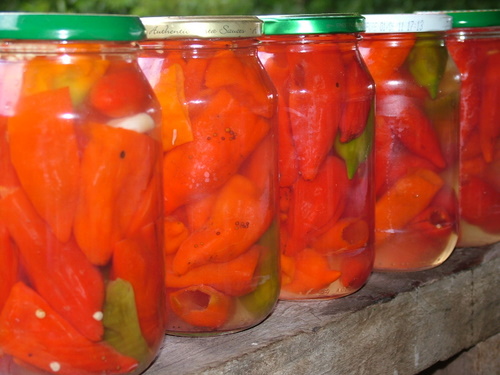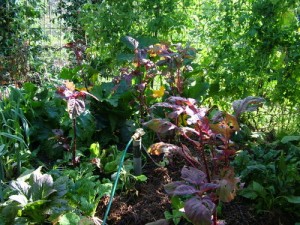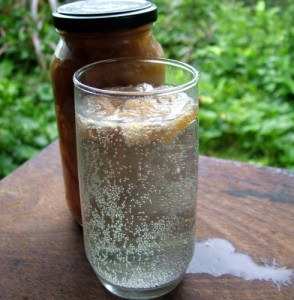I am picking lots of chilis, but it is too early yet for enough lemons to make Chili Jam, so it’s chili pickling time.
Once upon a time, in an effort to be the original Earth Mama I used to spend hours enveloped in steam, making pickles and jams and chutneys and vacola jars of preserves out of everything that could have vinegar, sugar and/or salt added to it. But if there is a fresh substitute for a preserved food, I’ll choose the fresh every time. Even where I like the sweet, salty tangy-ness of a preserve I know too much of it isn’t good for me. So these days a pickle has to really earn its place.
Preserves make lots of sense in climates where everything green is covered in snow for several months of the year, but here winter is actually a better gardening season than spring. Preserves as insurance against crop failure make sense, but with enough variety there is generally something that likes the season whatever it is. Preserves as a way of dealing with excesses makes sense, but a nice little local bartering circle is a lot easier and more fun.
But preserves as a way of having chili in winter and spring – now that makes sense!
I like chili. Have you noticed? My partner likes it even more. This is a nice simple way to preserve chilis for use in curries and stir fries and bean dishes over the season when there are no fresh chilis. Pickled chilis are also wonderful on the verandah on a hot afternoon with cold beer, nashi pear, sharp cheese, a backgammon board, and a friend or two. This is a very fast, easy recipe, and the spiced chili vinegar left when all the pickles have been eaten is perfect in salad dressings.
The Recipe:
The object of this is to pour hot, spiced vinegar over raw, de-seeded chilis packed into hot sterilized jars. If the jars are cold, you risk cracking them when you pour in the hot vinegar. So you need to have several processes happening at once so it all comes together.
So the first thing to do is to put your jars and their lids on to boil for 10 minutes or pressure cook for 5 minutes to sterilize them.
At the same time, heat your vinegar.
Because the chilis are hollow, most of the jar will be filled with the pickling vinegar. So you will need enough vinegar to fill the jars about two-thirds full. So estimate how many jars you will fill with chilis and do a little bit of maths to figure out how much vinegar to make. You can use malt or cider vinegar, but I use just plain white vinegar.
Most metals will react with the vinegar, so use a stainless steel or enamel pot. For each 750ml of vinegar, add:
- 2 tablespoons of cooking salt
- 1 tablespoon brown sugar
- optional – some spices. I like about half a teaspoon of black peppercorns, half a teaspoon of mustard seeds, half a teaspoon of dill seeds, and a clove of garlic per jar. My local health food shop also sells “Pickling Spices” loose. It’s a mixture of mustard seeds, coriander, peppercorns, cloves, ginger, cinnamon sticks, and bay leaves. So a couple of teaspoons of that per jar is also an option.
Bring to the boil and boil for a few minutes, just to dissolve the salt and sugar and soften the spices.
While that is happening, chop the tops off your chilis and swivel the point of a knife blade round inside them to loosen the seeds. Use gloves or really, really remember not to touch your eyes for hours afterwards! Rinse under running water to remove most of the seeds. There is no need to be very diligent about this. The main aim is to allow the pickling vinegar to get inside the chilis.
Pack the sterilized jars full of de-seeded chilis. Try to get them with the open end up, so they fill with vinegar rather than try to float, and leave a centimetre or so headroom. Before the jar gets cold, pour the hot spiced vinegar over the chilis to fill the jar, making sure the chilis are completely covered. Screw the sterilized lid onto the jar.
As the jar cools, the middle of the lid should pop in, showing that you have an airtight seal. This isn’t so critical – the salt, sugar and vinegar will preserve the chilis anyhow, but I feel more secure knowing they are hermetically sealed.
Leave for at least a few weeks before using.




Love it! Yes, preserving can be hard work, though it feels satisfying knowing that food in your cupboard is home grown, and home processed! It is also a good skill to have, I think. There has to be a balance though, and preserving the things you love and will eat is a good way to make the decision!
great site, enjoy your posts … especially love the gardening and animal posts but that’s just my thing … thanks for brightening the world a little fiona p.s the resident python is a constant source of ghoulish joy for me! hope the chooks are keeping at wing length.
Hi Fiona, I’m glad you like it! So far all the chooks are surviving and happy. We added a rooster yesterday so the girls now have a very pretty boy to play with.
Hi Linda, what size chillies did you use? Last year I pickled the longer chilli peppers, like the ones bought pickled in delis. Slightly different to you, I kept them whole and on opening they were full of pickling juice. We only just cracked them last week and they’re far tastier than any we’ve bought from a store 🙂
I’m not sure what these ones are called. They are a variety that self sows in my garden – about 7 or 8 cm long. It’s interesting that the pickling juice got inside yours – I will try that next time – would save a bit of work.
Pingback:Tamarillo and Chili Sauce
Pingback:In My Kitchen
Pingback:Camilla’s Chilis Rellenos